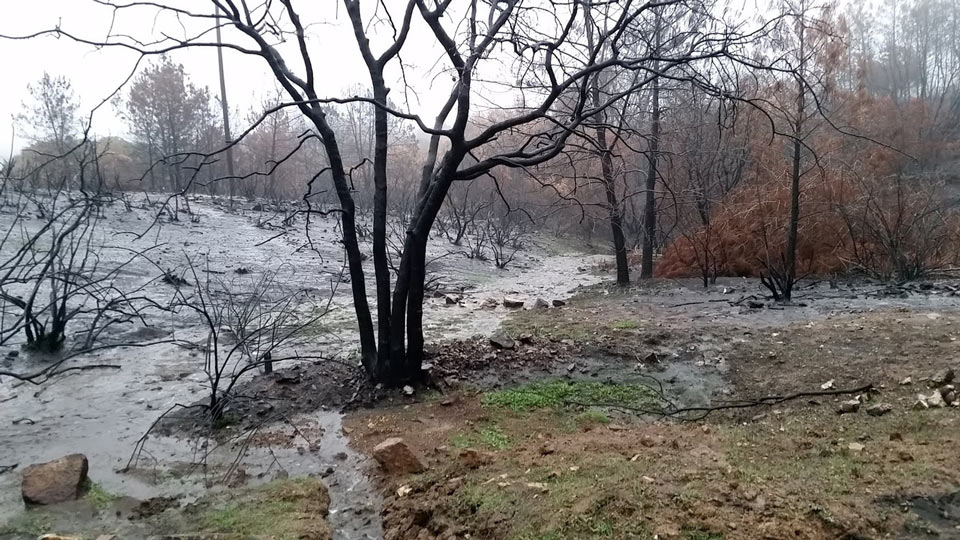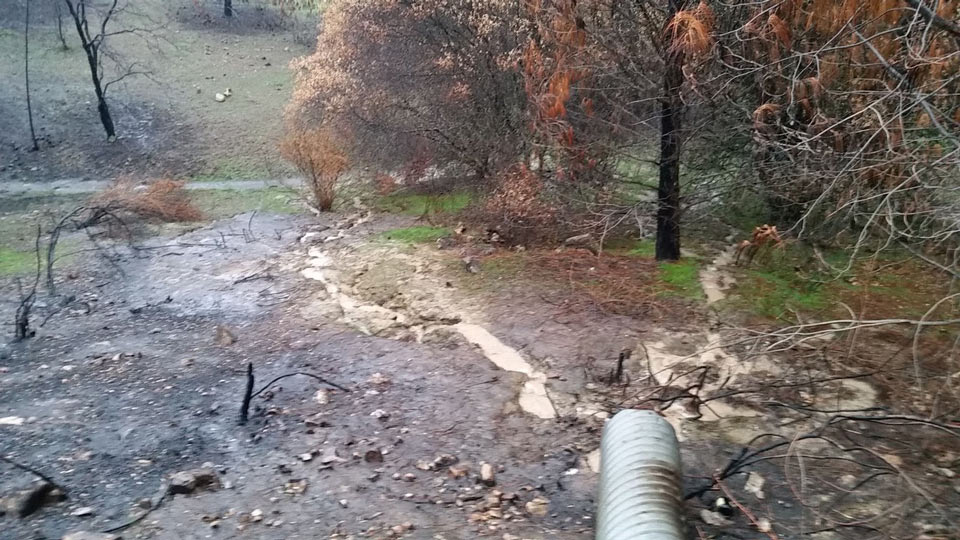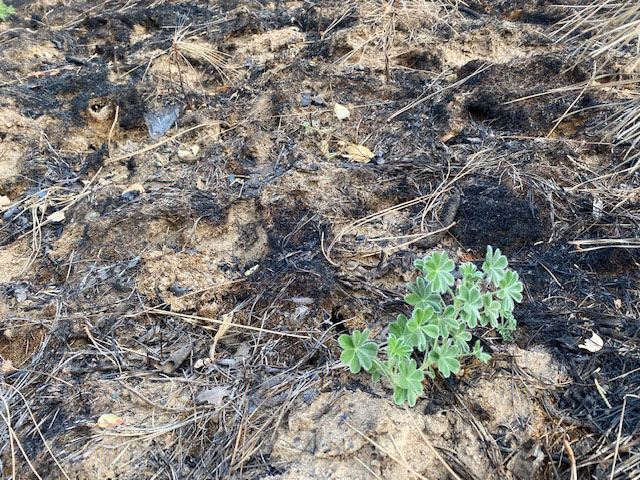Do your part to prevent human caused wildfire: Part 5
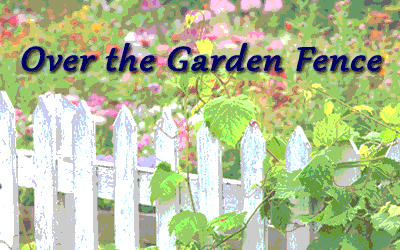 September 26, 2022 – By Michele Nowak-Sharkey, UC Master Gardener of Mariposa County – The largest natural cause of fire is lighting. However, most fires are human caused. The percentage varies from 89% – 95% depending on the source. With the increase in drought, fuel build-up in unburned forests, earlier springs, higher temperatures, beetle infested weakened trees, with the addition of a bit of wind and the same actions that might have easily extinguished a small fire in the past are now creating dangerous infernos.
September 26, 2022 – By Michele Nowak-Sharkey, UC Master Gardener of Mariposa County – The largest natural cause of fire is lighting. However, most fires are human caused. The percentage varies from 89% – 95% depending on the source. With the increase in drought, fuel build-up in unburned forests, earlier springs, higher temperatures, beetle infested weakened trees, with the addition of a bit of wind and the same actions that might have easily extinguished a small fire in the past are now creating dangerous infernos.
Being aware of our everyday choices can impact the number and magnitude of fires in the future.
(https://www.nifc.gov/fire-information/fire-prevention-education-mitigation/wildfire-investigation)
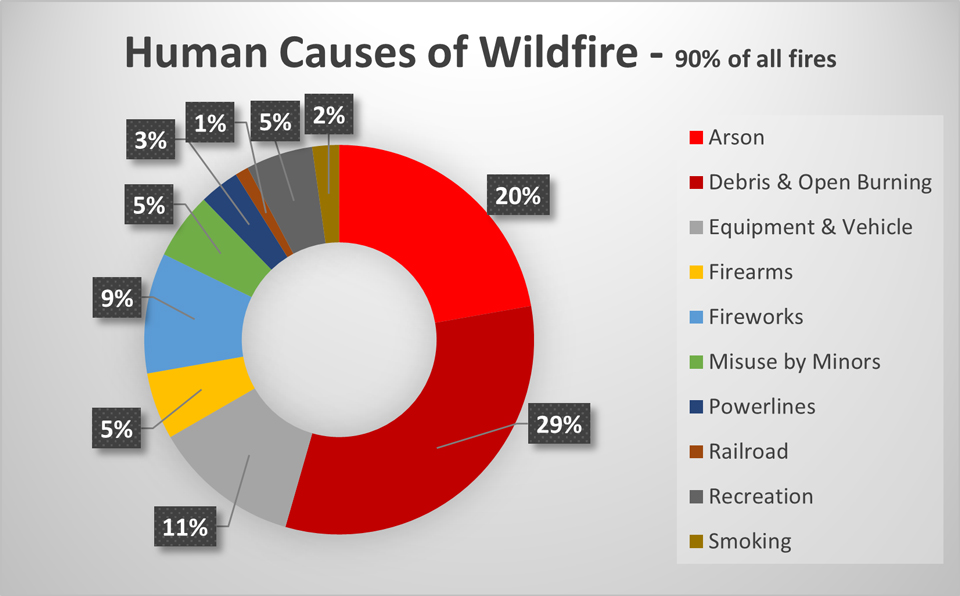
Debris and open burning include burn piles, yard debris, burn barrels, ditch/fence line burning, pest control, open trash burning, burning personal items, distress/signal fires, land clearing, right-of-way hazard reduction, or other escaped controlled burning. Windblown embers or fire creeping from the control burn area into un-cleared vegetation are the primary ignition mechanisms.
How to prevent: Landscape debris piles must be in 4 feet by 4 feet piles. Clear all flammable material and vegetation within 10 feet of the outer edge of pile.
Keep a water supply and shovel close by.
A responsible adult is required by law to be in attendance until the fire is out.
Stay mindful of current weather conditions when burning. If it’s windy and the surrounding vegetation is very dry, it may be best to wait and burn another day.
Check Mariposa County for burn permit requirements. 209 966-1200. (https://cemariposa.ucanr.edu/Fire_Information/Permits_and_Regulations/Mariposa_County_Permitting)
Arson is the criminal act of deliberately or maliciously setting fire to property including public lands with the intent to damage or defraud. Devices and “hot sets” are commonly used to ignite fires.
How to prevent: If you see or know of unusual activity in an area where wildfires are occurring, report it immediately. Note descriptions of vehicles and people in the area including dates, times, and location. Photos and videos are extremely helpful!
Equipment/Vehicle fires range from heavy construction to small portable engines (passenger vehicles/RVs, motorcycles, OHV, ATV, trailers, road graders, bulldozers, tractor trailers, welders, grinders, wind generators, chain saws, pumps, generators, etc.).
Ignitions sources are mechanical breakdowns/malfunctions such as exhaust (direct heat transfer, organic material collecting on the exhaust system, and particles), catalytic converter pieces, hot metal fragments, metal/pavement contact (dragging trailer chains and metal parts), friction, flat tires, spark arrestor malfunctions, faulty electrical system/wiring, collisions, refueling operations, and rock/hard surface strikes.
How to Prevent: Perform regular maintenance on your vehicles – secure chains, inspect for dragging parts, check tire pressure, and properly maintain brakes. Visit Ready for Wildfire equipment use for more prevention tips. (https://www.readyforwildfire.org/prevent-wildfire/equipment-use)
Firearms and explosives use requires being aware of any firearm projectiles along with flares from flare guns and signal flares.
How to Prevent: Explosives, exploding targets, incendiary ammunition and tracer bullets are prohibited on public lands during high fire danger. Check for fire restrictions and prohibited uses in the area. To prevent wildfires while target shooting, follow these tips:
Bring a shovel and water or fire extinguisher.
Place your targets on dirt or gravel, clear and away from grass and other vegetation.
If fire danger is high (dry, hot, and windy) consider shooting at an established outdoor or indoor range.
Know your ammunition – don’t shoot steel component, tracer, or incendiary bullets.
Bullets can spark when striking solid objects, sending hot fragments into vegetation – don’t shoot trash like TVs and appliances or at rocks and metal targets such as signs.
Fireworks burn at extremely elevated temperatures making all fireworks ignition sources especially the airborne type (i.e., bottle rockets and roman candles). Even sparklers burn at 1200°F.
How to prevent: Despite the dangers of fireworks, few people understand the associated risks – devastating burns, other injuries, fires, and even death. During times of high fire danger, federal and local agencies impose fire restrictions and/or fire prevention orders.
Misuse of fire by minors has its own category. Young children, ages 12 or younger, motivated by normal curiosity may use fire in an experimental fashion; “playing with matches.” They look for easily accessible ignition devices and frequently use both paper and wood matches, lighters, fireworks, or magnifying glasses to ignite fires.
How to prevent: Set a good example and teach children fire safety at an early age. The most critical message for children to learn is that matches, and lighters are tools and not toys! Parents should never use lighters, matches and fire for fun – children will mimic the behavior,
Power line caused wildfires are often due to high winds, contact with vegetation, equipment failure, or human or animal contact with a power line (conductor wire). Several of these factors may work to cause a fire, such as wind blowing vegetation into contact with the electrical equipment.
How to prevent: Proper maintenance including vegetation clearance around equipment can help prevent wildfires. For your safety, however, stay away from power lines, meters, transformers, and electrical boxes. Leave the maintenance to the professionals – if you see vegetation close or in contact with power lines or bird nest close to the lines or conductor boxes, notify your utility company.
Recreation and ceremony include campfires improperly constructed, unattended, improperly extinguished, or abandoned; barbeque/smokers; bonfires; ceremonial fires; gas cookers, warming and lighting devices; luminary (sky lanterns); and outdoor fireplaces, metal fire rings and candles.
How to Prevent: Learn how to construct a proper campfire and how to put it out. (https://smokeybear.com/en/prevention-how-tos/campfire-safety) Never leave grills and smokers unattended. Watch weather conditions closely when considering have a bonfire, ceremonial fire or using candles.
Smoking fires are generated from discarded unextinguished cigarettes and other materials used for smoking. Wildfires caused by smoking activities or accoutrements, include matches, cigarettes, cigars, pipes, electronic cigarettes (vape heads), and drug paraphernalia.
How to Prevent: Never flick cigarette butts out the window. Watch where you toss used matches and other smoking accoutrements. Beware of wind conditions when using such paraphernalia.
We want to get back to fire as a beneficial effect on the landscape rather than a damaging effect.
As Smokey says “Only YOU can help prevent wildfires” by our personal actions and the actions we take as a community.
Next Up: Defensible Space and How to Create It
Related:
Over the Garden Fence – The Partnership Between Humans and Nature During Fire Recovery: Part 4
Over the Garden Fence – The Partnership Between Humans and Nature During Fire Recovery: Part 3
Over the Garden Fence – The Partnership Between Humans and Nature During Fire Recovery: Part 2
Over the Garden Fence – The Partnership Between Humans and Nature During Fire Recovery
For assistance, contact our Helpline at (209) 966-7078 or at mgmariposa@ucdavis.edu. We are currently unable to take samples or meet with you in person but welcome pictures.
The U.C. Master Gardener Helpline is staffed; Tuesdays from 9:00 A.M. – 12:00 P.M. and Thursdays from 2:00 P.M. – 5:00 P.M.
Clients may bring samples to the Agricultural Extension Office located at the Mariposa Fairgrounds, but the Master Gardener office is not open to the public. We will not be doing home visits this year due to UCANR restrictions.
Serving Mariposa County, including Greeley Hill, Coulterville, and Don Pedro
Please contact the helpline, or leave a message by phone at: (209) 966-7078
By email (send photos and questions for researched answers) to: mgmariposa@ucdavis.edu
For further gardening information and event announcements, please visit: UCMG website: https://cemariposa.ucanr.edu/Master_Gardener
Follow us on Facebook at: https://www.facebook.com/mariposamastergardeners
Master Gardener Office Location:
UC Cooperative Extension Office,
5009 Fairgrounds Road
Mariposa, CA 95338
Phone: (209) 966-2417
Email: mgmariposa@ucdavis.edu
Website: http://cemariposa.ucanr.edu/Master_Gardener
Visit the YouTube channel at UCCE Mariposa.
 landscapes on private properties and substantial areas of the adjoining Sierra National Forest were affected. This article explains how to plant conifer seedlings for post-fire forest restoration.
landscapes on private properties and substantial areas of the adjoining Sierra National Forest were affected. This article explains how to plant conifer seedlings for post-fire forest restoration.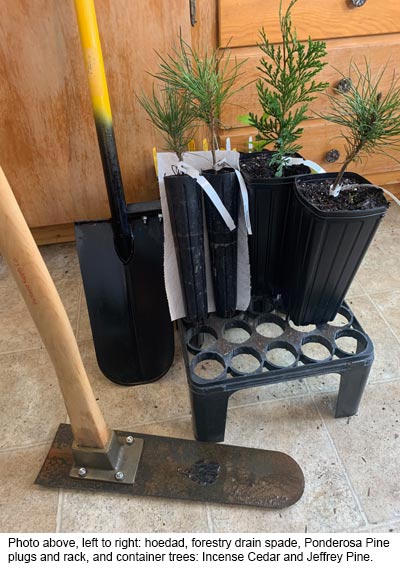 Planting a potted seedling is straightforward. Clear the spot of any slash to expose the underlying soil. A site on the shady side of a stump or log is perfect. With a post-hole shovel (a drain spade), dig a hole about twice the volume of the tree pot and deep enough so that the pot soil matches the surrounding ground level. Tip the potted plant over, letting it slide out, and settle it into the hole. Refill the hole with native soil.
Planting a potted seedling is straightforward. Clear the spot of any slash to expose the underlying soil. A site on the shady side of a stump or log is perfect. With a post-hole shovel (a drain spade), dig a hole about twice the volume of the tree pot and deep enough so that the pot soil matches the surrounding ground level. Tip the potted plant over, letting it slide out, and settle it into the hole. Refill the hole with native soil.

